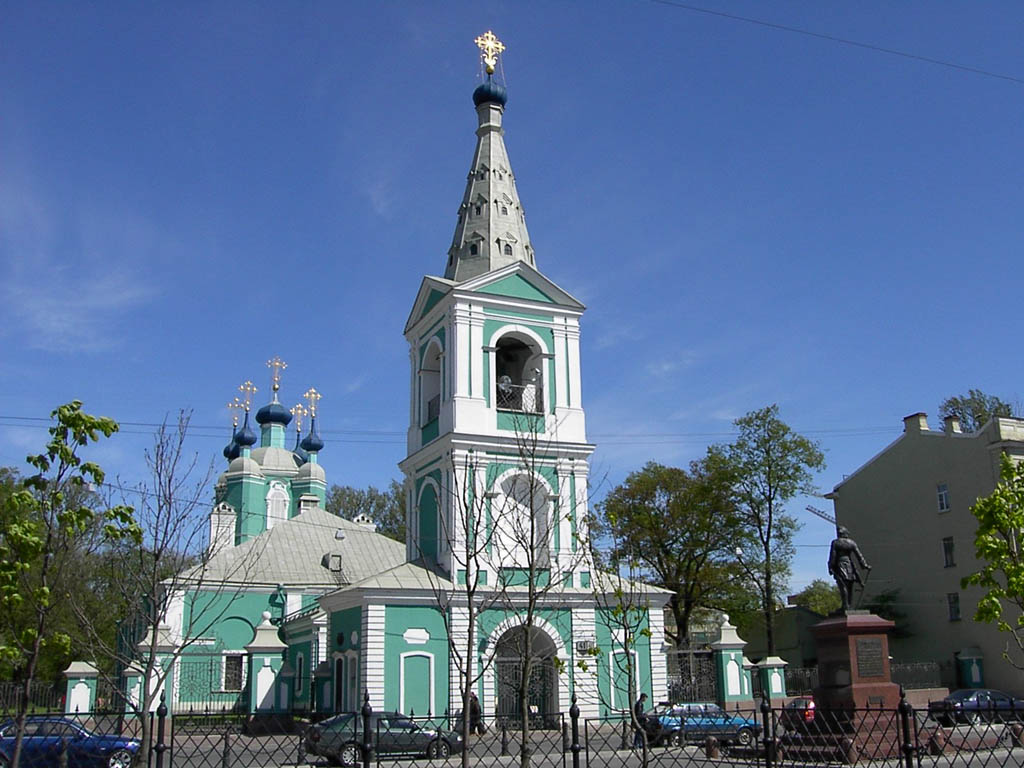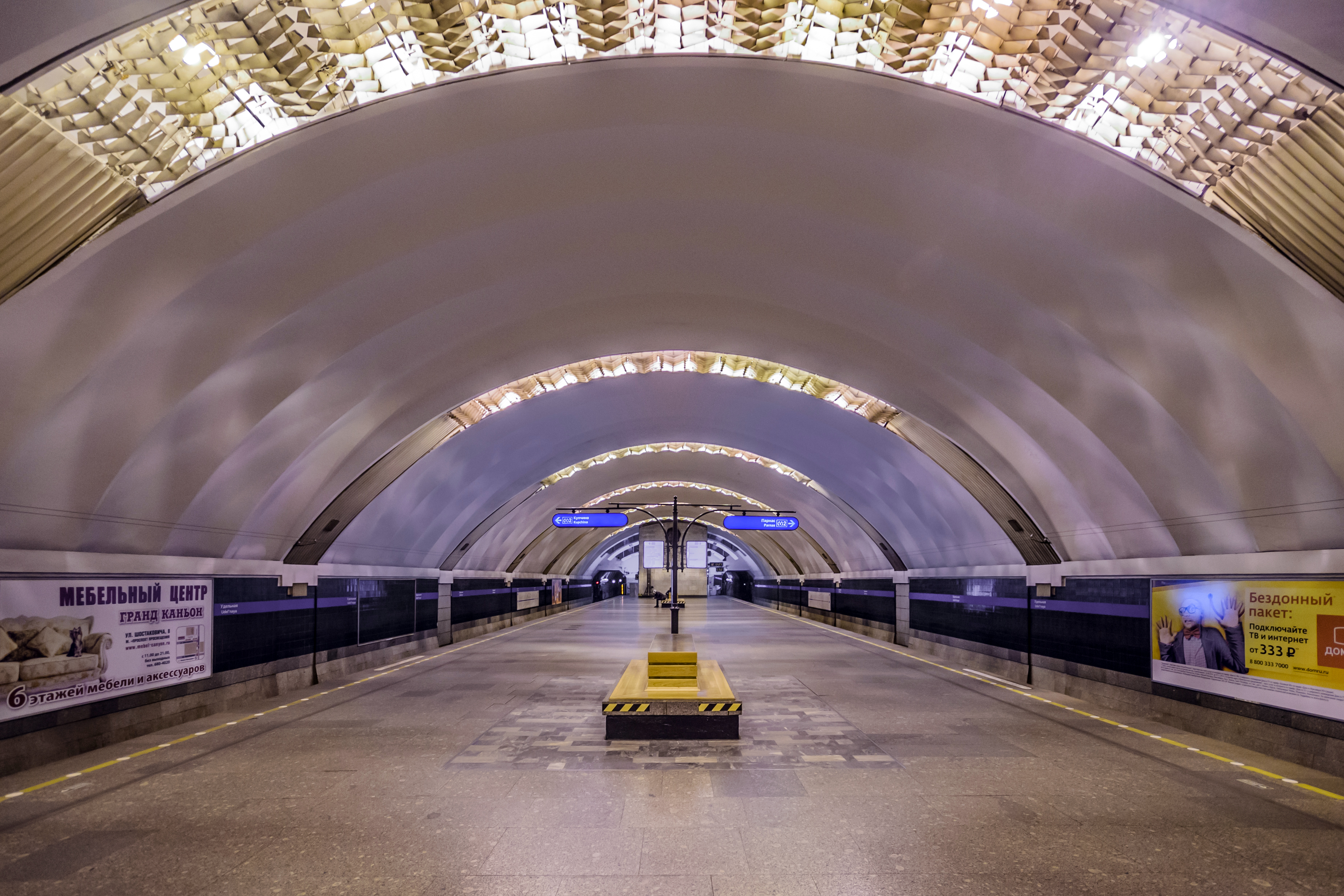|
Parnas (Saint Petersburg Metro)
Parnas (russian: Парна́с) is the northern terminus of the Moskovsko-Petrogradskaya Line of the Saint Petersburg Metro. It was opened on 22 December 2006 and is located between the tunnel portal and the Vyborgskoye Metro Depot. It is the northernmost subway station in Saint Petersburg and in Russia. The station is side-platform arrangement almost identical to the other three surface stations in the system: Kupchino, Rybatskoye and Devyatkino, which are also located between tunnel portals and their lines' depots, however unlike those stations there is no transfer to the suburban commuter trains (elektrichkas). The station was first mentioned in 1984, as a finale of the Petrogradsky radius extension that was built throughout the 1980s from the city centre into the northern housing massifs. The northernmost end would include a second depot for the line and a surface terminus station next to a new housing massif that would be located near the industrial zones of Parnas and Sh ... [...More Info...] [...Related Items...] OR: [Wikipedia] [Google] [Baidu] |
Vyborgsky District, Saint Petersburg
Vyborgsky District ( rus, Вы́боргский райо́н, links=1, r=Výborgskiy raión, p=ˈvɨbərkskʲɪj rɐˈjɵn) is an administrative and municipal district (raion), one of the 18 in Saint Petersburg, Russia. History and present Overview and early decades This historical north-western area of St. Petersburg was named after the castle town of Vyborg (Rus. Выборг - a transcription of its Finnish name ''Viipuri'') after the latter was taken from Swedish Empire (which then included present-day Finland) by the Imperial Russian Army under the command Tsar Peter the Great during the Great Northern War of early 18th century, thus safeguarding the new Russian capital St. Petersburg. This north-western area of the city was the nearest to Vyborg and has been connected to it by major roads which have almost never lost their significance as international transportation routes. This part of the city, divided in the 20th century longitudinally between Vyborgski and Kalinin ... [...More Info...] [...Related Items...] OR: [Wikipedia] [Google] [Baidu] |
Saint Petersburg
Saint Petersburg ( rus, links=no, Санкт-Петербург, a=Ru-Sankt Peterburg Leningrad Petrograd Piter.ogg, r=Sankt-Peterburg, p=ˈsankt pʲɪtʲɪrˈburk), formerly known as Petrograd (1914–1924) and later Leningrad (1924–1991), is the second-largest city in Russia. It is situated on the Neva River, at the head of the Gulf of Finland on the Baltic Sea, with a population of roughly 5.4 million residents. Saint Petersburg is the fourth-most populous city in Europe after Istanbul, Moscow and London, the most populous city on the Baltic Sea, and the world's northernmost city of more than 1 million residents. As Russia's Imperial capital, and a historically strategic port, it is governed as a federal city. The city was founded by Tsar Peter the Great on 27 May 1703 on the site of a captured Swedish fortress, and was named after apostle Saint Peter. In Russia, Saint Petersburg is historically and culturally associated wi ... [...More Info...] [...Related Items...] OR: [Wikipedia] [Google] [Baidu] |
Russia
Russia (, , ), or the Russian Federation, is a transcontinental country spanning Eastern Europe and Northern Asia. It is the largest country in the world, with its internationally recognised territory covering , and encompassing one-eighth of Earth's inhabitable landmass. Russia extends across eleven time zones and shares land boundaries with fourteen countries, more than any other country but China. It is the world's ninth-most populous country and Europe's most populous country, with a population of 146 million people. The country's capital and largest city is Moscow, the largest city entirely within Europe. Saint Petersburg is Russia's cultural centre and second-largest city. Other major urban areas include Novosibirsk, Yekaterinburg, Nizhny Novgorod, and Kazan. The East Slavs emerged as a recognisable group in Europe between the 3rd and 8th centuries CE. Kievan Rus' arose as a state in the 9th century, and in 988, it adopted Orthodox Christianity from t ... [...More Info...] [...Related Items...] OR: [Wikipedia] [Google] [Baidu] |
Side Platforms
A side platform (also known as a marginal platform or a single-face platform) is a platform positioned to the side of one or more railway tracks or guideways at a railway station, tram stop, or transitway. A station having dual side platforms, one for each direction of travel, is the basic design used for double-track railway lines (as opposed to, for instance, the island platform where a single platform lies between the tracks). Side platforms may result in a wider overall footprint for the station compared with an island platform where a single width of platform can be shared by riders using either track. In some stations, the two side platforms are connected by a footbridge running above and over the tracks. While a pair of side platforms is often provided on a dual-track line, a single side platform is usually sufficient for a single-track line. Layout Where the station is close to a level crossing (grade crossing) the platforms may either be on the same side of the cross ... [...More Info...] [...Related Items...] OR: [Wikipedia] [Google] [Baidu] |
Third Rail
A third rail, also known as a live rail, electric rail or conductor rail, is a method of providing electric power to a railway locomotive or train, through a semi-continuous rigid conductor placed alongside or between the rails of a railway track. It is used typically in a mass transit or rapid transit system, which has alignments in its own corridors, fully or almost fully segregated from the outside environment. Third rail systems are usually supplied from direct current electricity. Modern tram systems, street-running, avoid the risk of electrocution by the exposed electric rail by implementing a segmented ground-level power supply, where each segment is electrified only while covered by a vehicle which is using its power. The third-rail system of electrification is not related to the third rail used in dual gauge railways. Description Third-rail systems are a means of providing electric traction power to trains using an additional rail (called a "conductor rail") ... [...More Info...] [...Related Items...] OR: [Wikipedia] [Google] [Baidu] |
Saint Petersburg Metro
The Saint Petersburg Metro (russian: links=no, Петербургский метрополитен, Peterburgskiy metropoliten) is a rapid transit system in Saint Petersburg, Russia. Construction began in early 1941, but was put on hold due to World War II and the subsequent Siege of Leningrad, during which the constructed stations were used as bomb shelters. It was finally opened on 15 November 1955. Formerly known as the ''Order of Lenin Leningrad Metro named after V. I. Lenin'' (), the system exhibits many typical Soviet designs and features exquisite decorations and artwork making it one of the most attractive and elegant metros in the world. Due to the city's unique geology, the Saint Petersburg Metro is also one of the deepest metro systems in the world and the deepest by the average depth of all the stations. The system's deepest station, Admiralteyskaya, is below ground. The network consists of 5 lines with a total length of . It has 72 stations including 7 transfer ... [...More Info...] [...Related Items...] OR: [Wikipedia] [Google] [Baidu] |
Moskovsko-Petrogradskaya Line
Line 2 of the Saint Petersburg Metro, also known as ''Moskovsko-Petrogradskaya Line'' (russian: Моско́вско-Петрогра́дская ли́ния) or ''Blue Line'', is a second oldest rapid transit line in Saint Petersburg, Russia, opened in 1961, which connects city centre with the northern and southern districts. It featured the first cross-platform transfer in the USSR. It was also the first metro line in Saint Petersburg to feature a unique platform type that soon became dubbed as "Horizontal Lift". The line cuts Saint Petersburg on a north-south axis and is generally coloured blue on Metro maps. In 2006, as an extension was opened, it became the longest line on the system. Timeline Name changes Transfers The Tekhnologichesky Institut transfer is a cross-platform one. Rolling stock The line is served by the Moskovskoe (№ 3) depot Depot ( or ) may refer to: Places * Depot, Poland, a village * Depot Island, Kemp Land, Antarctica * Depot Island, Vi ... [...More Info...] [...Related Items...] OR: [Wikipedia] [Google] [Baidu] |
Kupchino (Saint Petersburg Metro)
Kupchino (russian: Ку́пчино) is a station on the Moskovsko-Petrogradskaya Line of the Saint Petersburg Metro. It was opened on December 25, 1972. It was designed by K.N. Afonskya, A.C. Getskin and I.E. Sergeyeva. According to the original plans, the station was initially supposed to be called "Vitebskaya". The station received its final name after a small village Kupchino, that is located 2 km to the North of the station. Kupchino is the oldest surviving above-ground station in Saint Peterburg (the since-demolished Dachnoye predates it by several years). It has a transfer link-up to Kupchino Station of the Vitebskya Railroad. It also has two exits to outside the station, as well as a long tunnel that leads to Vitebsky Prospect. The most famous resident of Kupchino is arguably the third President and previous Prime Minister of Russia Dmitry Medvedev, who grew up in this area. Another famous resident of the neighborhood is the mathematician Grigori Perelman. Transi ... [...More Info...] [...Related Items...] OR: [Wikipedia] [Google] [Baidu] |
Rybatskoye (Saint Petersburg Metro)
Rybatskoye (russian: Рыба́цкое) is a station on the Nevsko–Vasileostrovskaya Line of Saint Petersburg Metro, opened on 28 December 1984. Design features Rybatskoye is one of the 5 stations of the St. Petersburg metro that are located at ground level, with the other four being Kupchino, Devyatkino, Parnas and Shushary. Like with the other four stations, behind Rybatskoye begins the depot of the same name, which serves lines 3, 4, and more recently, also line 5. Furthermore, it's also adjacent to the eponymous railway station on the Saint Petersburg–Moscow railway The Saint Petersburg to Moscow railway (1855–1923 – ''Nikolaevskaya railway'') runs for through four oblasts: Leningrad, Novgorod, Tver and Moscow. It is a major traffic artery in the north-west region of Russia, operated by the October Ra .... Saint Petersburg Metro stations Railway stations in Russia opened in 1984 {{Russia-railstation-stub ... [...More Info...] [...Related Items...] OR: [Wikipedia] [Google] [Baidu] |
Devyatkino (St
Devyatkino is a locality near Saint Petersburg, Russia, and may refer to: * Novoye Devyatkino (New Devyatkino) (Новое Девяткино) town in Novodevyatkinskogo rural settlement, Vsevolozhsky District * Devyatkino (St. Petersburg Metro) * Devyatkino (railroad station) Devyatkino is a locality near Saint Petersburg, Russia, and may refer to: * Novoye Devyatkino (New Devyatkino) (Новое Девяткино) town in Novodevyatkinskogo rural settlement, Vsevolozhsky District Vsevolozhsky District (russian: В ... * Devyatkino (bus terminal) {{disambig ... [...More Info...] [...Related Items...] OR: [Wikipedia] [Google] [Baidu] |
Elektrichka
Elektrichka (russian: электри́чка, p=əlʲɪˈktrʲitɕkə; uk, електри́чка, elektrychka) is a Soviet and Eastern bloc commuter (regional) mostly suburban electrical multiple unit passenger train. Elektrichkas are widespread in Russia, Ukraine and other countries of the former Warsaw Pact presenting a socially vital mode of transportation. In 2007, 4085 commuter trains a day (in each direction) were running on the Russian Railways network alone, most of them electric. The first ''elektrichka'' train on July 6, 1926, along the Baku– Sabunchi line in Soviet Azerbaijan. Also urban (intra-city) ''gorodskaya elektrichkas'' and airport's '' aeroexpresses'' exist in a few cities of Russia, Ukraine, and Belarus. Name "Elektrichka" was initially a colloquial abbreviation for ''elektropoyezd'' (russian: электропо́езд, electric train), the official term for electrical multiple unit passenger train in respective languages. However, it is gradually becom ... [...More Info...] [...Related Items...] OR: [Wikipedia] [Google] [Baidu] |
Prospekt Prosvescheniya (Saint Petersburg Metro)
Prospekt Prosvescheniya (russian: Проспéкт Просвещéния, Education avenue) is a station of the Saint Petersburg Metro The Saint Petersburg Metro (russian: links=no, Петербургский метрополитен, Peterburgskiy metropoliten) is a rapid transit system in Saint Petersburg, Russia. Construction began in early 1941, but was put on hold due to Wor ... located between stations Ozerki and Parnas. It took its name from a nearby avenue. It was opened on 19 August 1988. Saint Petersburg Metro stations Railway stations in Russia opened in 1988 1988 establishments in the Soviet Union Railway stations located underground in Russia {{Russia-railstation-stub ... [...More Info...] [...Related Items...] OR: [Wikipedia] [Google] [Baidu] |


.jpg)

